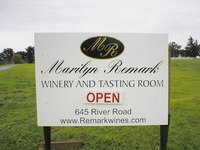I have never actually gone out of my way to be labeled “deranged”–but then Joel Burnstein told me that his Marilyn Remark wines have “a small, loyal, and slightly deranged following.” Count me in.
then Joel Burnstein told me that his Marilyn Remark wines have “a small, loyal, and slightly deranged following.” Count me in.
To be honest, I’d never really heard of this label until I made a trip to the Monterey region’s River Road Wine Trail a few weeks ago. Spread out along the slopes of the Salinas Valley about two hours south of San Francisco, this rustic, rural landscape is home to plenty of familiar, outstanding wineries including Chalone, Hahn, Paraiso, Talbott, and Mer Soleil.
But Marilyn Remark? Someone I’d recently met had mentioned that the wines were good, but I had a full schedule of wineries to visit that day and was disinclined to waste time on one that I didn’t know. As I  drove towards the unprepossessing place–light years away from Napa Valley’s glitzy showplace wineries!–I was tempted to keep going, but on an impulse I pulled into the driveway instead of just zipping by on my way to more well-known establishments and made my way into the converted barn-winery-tasting room. I found the owner, Joel Burnstein, puttering around the premises.
drove towards the unprepossessing place–light years away from Napa Valley’s glitzy showplace wineries!–I was tempted to keep going, but on an impulse I pulled into the driveway instead of just zipping by on my way to more well-known establishments and made my way into the converted barn-winery-tasting room. I found the owner, Joel Burnstein, puttering around the premises.
Instead of the Chardonnay and Pinot Noir that are the most widely produced varietals in the Monterey wine region, Burnstein concentrates on the type of wines made in the Rhône Valley. When I tasted them I was utterly gobsmacked by the high quality of these wines and by their genuine Rhône-like character.
The 2008 golden colored Roussanne had a honeysuckle perfume and both honey and minerality on the palate, plus a long, satisfying finish. If you ever doubted that rosé is capable of great sophistication, try Marilyn Remark’s 2007 Rosé de Saignée, which is bone dry and crisp, with penetrating strawberry flavors. The signature Grenache from the Los Ositos Vineyard floods the senses with bright blueberry, cassis and blackberry, while Grenache from the warmer Wildhorse Vineyard veers towards raspberry and chocolate elements, with big, round, sumptuous tannins. Syrah–the backbone of Hermitage and Côte Rôtie–is here appropriately supple and complex, revealing hints of summer plums, juicy blackberries, leather and vanilla. The 2008 VMR (Viognier, Marsanne, Roussanne) from the Loma Pacific Vineyard (Monterey/Arroyo Seco appellation) had a sweet almost floral aroma, great texture, and the long, refreshing acidic finish that characterizes the best Monterey wines. With a production of only about 2000 cases, the wines aren’t easy to find, but well worth seeking out. Prices range from $22 to $45.
So who IS this guy Joel Burnstein? He tells me that a mid-life career change is what brought him into wine from being a trader on the Pacific Stock Exchange in San Francisco. He was already a devoted wine consumer, but a 3-week trip to France with his wife, Marilyn Remark, was the pivotal point in his life. “We had driven from Champagne down to Cannes,” he recalls, “but we didn’t really like Cannes so we turned around and headed back to Champagne. Along the way we stopped for lunch in Châteauneuf-du-Pape. About midway through the meal I looked at Marilyn and said, ‘This is what I want to do.’ That was either the biggest mistake of our lives, or the best thing that ever happened to me. It depends which day you ask me about it.”
was the pivotal point in his life. “We had driven from Champagne down to Cannes,” he recalls, “but we didn’t really like Cannes so we turned around and headed back to Champagne. Along the way we stopped for lunch in Châteauneuf-du-Pape. About midway through the meal I looked at Marilyn and said, ‘This is what I want to do.’ That was either the biggest mistake of our lives, or the best thing that ever happened to me. It depends which day you ask me about it.”
Burnstein went home and enrolled in enology studies at Fresno State University. He then had an internship at Sterling Vineyards and ultimately became winemaker at Jekel and San Saba. His basic winemaking philosophy is pretty straightforward: “Making good wine is a two-step process. One: Get great grapes. Two: Don’t screw it up.” As for me, I’ve now developed my own two-step philosophy for wine tasting. One: Keep an open mind and don’t just go back again and again to the wines you know–keep trying new labels, new regions, new grape varietals. Two: When it comes to wine, don’t be afraid of being labeled “deranged.”
7
